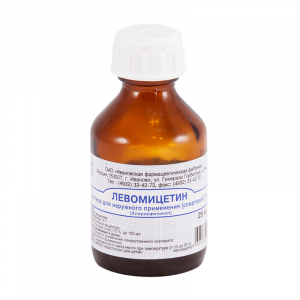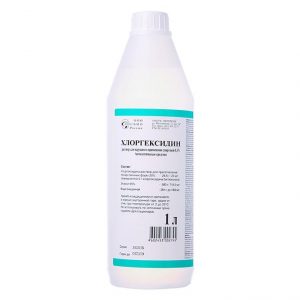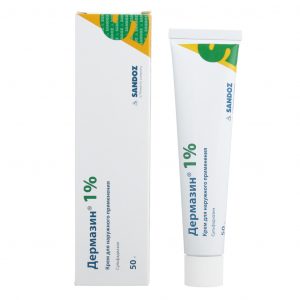Description
Release form
Ointment.
Packaging
Tube 20 g.
Pharmacological action
Pharmacodynamics.
Povidone-iodine – an antiseptic, which is a complex of iodine and povidone, effective at a pH of 2 to 7. The bactericidal effect is due to free active iodine, which is released from the complex of povidone-iodine in the ointment.
Free iodine as a strong oxidizing agent reacts at the molecular level with insoluble fatty acids and practically non-oxidizing SH- and OH-groups of amino acids in enzymes and the main structural components of bacteria, both gram-positive and gram-negative, mycobacteria, fungi, especially Candida genus , various viruses and some protozoa.
However, for the complete inactivation of some viruses and bacterial spores, a sufficiently long period of exposure to the drug is necessary. There are no known cases of the development of resistance in microorganisms with prolonged use of povidone iodine.
Pharmacokinetics.
After applying the ointment, some absorption of iodine is possible, which must be taken into account depending on the place, amount and duration of the drug.
If small amounts of the drug are applied to intact skin, then iodine resorption is negligible. A high level of absorption may result from prolonged use of drugs containing povidone-iodine on extensive wounds and burns. As a result of this, a temporary increase in iodine in the blood is observed.
In people with a healthy thyroid, higher iodine levels do not entail clinically significant changes in the thyroid condition. In normal iodine metabolism, excess iodine is removed through the kidneys.
Indications
Post-traumatic and postoperative wounds of various localization, burns, trophic ulcers, bedsores.
Skin infections of various etiologies, including infectious dermatitis and eczema.
Damage to the skin of various origins (maceration, abrasions, bruises).
Contraindications
Hypersensitivity to the components of the drug.
Impaired thyroid function (thyrotoxicosis). Thyroid adenoma. Herpetiform dermatitis of D Ñhring. The simultaneous use of radioactive iodine.
Premature infants and children up to 6 months of age.
Composition
Active ingredient:
povidone-iodine (with 10% active iodine content) 10.0 g
Dosage and Administration
Externally. The drug is applied to the affected surface from one to several times a day until the symptoms of inflammation disappear.
If necessary, use dressings, gauze swabs and turundas. The multiplicity and duration of the ointment depends on the course of the wound process.
The course of treatment is 5-10 days.
Side effects
Hypersensitivity reactions to the drug are possible: delayed-type allergic reactions (itching, redness of the skin, blisters) or immediate-type allergic reactions (anaphylactoid reactions).
Long-term use of the drug (more than 7-10 days) and application to large surfaces of the skin, extensive wounds due to absorption can cause phenomena of iodism (metallic taste in the mouth, increased salivation and lacrimation, swelling of the mucous membranes) and systemic reactions (metabolic acidosis, hyponatremia, impaired renal and thyroid function), when they should stop using the drug and see a doctor.
Drug interaction
The drug is incompatible with alkaloids (celandine), tannic acid (tannin), salicylic acid, silver, bismuth, taurolidine and hydrogen peroxide salts.
In the presence of blood and pus, the drug binds to proteins and other organic compounds, as a result of which its bactericidal activity may decrease.
In this case, it is recommended to increase the frequency / frequency of its use. The simultaneous use of povidone iodine and topical preparations containing enzymes can contribute to the oxidation and suppression of their enzymatic activity.
Povidone-iodine has a synergistic effect with lithium preparations, as a result of which, with their long-term combined use, reversible inhibition of thyroid function is possible. Therefore, patients constantly taking lithium preparations should avoid prolonged application of povidone iodine on large surfaces.
The drug may produce false positive results in some diagnostic tests: determination of hemoglobin or sugar in urine and stool, examination of thyroid function, etc. An examination of the thyroid gland in this case should be carried out no earlier than 1-2 weeks after the end of treatment with povidone-iodine.
Overdose of
With intense iodine absorption over a long period, the following symptoms may be noted: tachycardia, agitation, trembling, and headache.
In this case, stop using the drug immediately and consult a doctor.
Storage conditions
Store in a dark place, out of reach of children at temperatures from 2 to 25 ° C.
Active substance
povidone-iodine
Terms and conditions
without prescription
Dosage form
ointment
Appointment
Dlya vzrosl h
Indications
Sores, Burns, Minor skin lesions, Trophic ulcers, Pyoderma, Wounds




